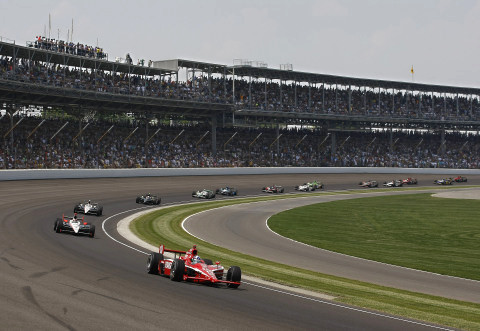The Way It Is/ Stability and date equity
by Gordon Kirby I'm constantly asked by race fans around the world why IndyCar no longer races at ovals like Michigan and Phoenix or classic road courses like Elkhart Lake or Laguna Seca. For those who didn't intimately follow the CART/IRL civil war over the past fifteen years it's difficult to understand. These tracks enjoyed excellent racing and equally large crowds for many years and should be naturals for IndyCar to race at again. But none are likely ever to stage another race for Indy cars.
I'm constantly asked by race fans around the world why IndyCar no longer races at ovals like Michigan and Phoenix or classic road courses like Elkhart Lake or Laguna Seca. For those who didn't intimately follow the CART/IRL civil war over the past fifteen years it's difficult to understand. These tracks enjoyed excellent racing and equally large crowds for many years and should be naturals for IndyCar to race at again. But none are likely ever to stage another race for Indy cars.
First of all it's salubrious to take on board that more than forty CART/Champ Car or IRL races failed over the fifteen-year duration of the infamous CART/IRL civil war. A handful of them have come back but the sad facts are that twenty-nine CART/Champ car races vanished or failed between 2000-'07 while the IRL burned through twenty different races some of which tried the IRL after giving up on CART or Champ Car. Seven of the IRL's original races failed and eleven CART/Champ Car races switched to the IRL only to fail again.
You can accurately reflect that over the time of this protracted battle enough damage was done to kill not one, but two series. It also badly damaged many regional markets. Some, like Michigan, Phoenix, Elkhart Lake and Lagna Seca had been very successful only a few short years before their death or departure from the world of Indy car racing. It was sad to see and I remember well Paul Newman arriving at Michigan on raceday morning in about 20002??
"Where's the crowd?" Newman inquired as he emerged from his rental car.
"Gone," I replied. "They're not here. I guess they're fed up with all this political bickering."
The message in all this is that the keys to success are focusing on the sport rather than politics and also establishing a stabile, solid schedule.

© LAT USA
*Twenty-one ovals: New Hampshire, Milwaukee and Las Vegas are being revived this year. But gone forever as Indy car venues it appears are Michigan, Fontana, Phoenix, Pikes Peak Speedway, Charlotte, Atlanta, Dover, Richmond, Nashville, Chicagoland and Homestead-Miami, plus Rockingham in UK, the Lausitzring in Germany and Rio de Janeiro's 'roval'. Disneyworld, Chicago, Nazareth and Gateway are out of business.
*Eleven temporary or street circuits: Detroit (Belle Isle), two circuits in Denver, Vancouver, San Jose, Surfers Paradise, two in Houston, Las Vegas, Miami and Cleveland.
*Eleven permanent road courses: Elkhart Lake, Laguna Seca, Portland, Montreal, Mexico City, Monterrey, St. Jovite, Brands Hatch, Zolder, Assen and Watkins Glen.
Takes your breathe away does it not?
It's interesting to reflect on which, if any, of these races might be revived and what might in a perfect world be the ideal schedule for IndyCar. The sad answer is that New Hampshire, Milwaukee and Las Vegas probably are the only tracks on the long list of lost venues likely to be revived. Remember that most of the above tracks suffered a serious run of red ink as they struggled to promote their races amid the CART/IRL war. It was a very unhealthy time for everyone involved and I'm not aware of any of those places who are anxious to experiment again with Indy car racing.
Of course, Michigan, Fontana and Phoenix are owned by the International Speedway Corporation (ISC), and Randy Bernard quickly came to the realization last year that ISC wasn't promoting its IndyCar races anywhere near vigorously enough. So he made a wise decision to leave those places behind. It's depressing to recall that Michigan and Fontana drew darn near full houses before suffering precipitous declines over a few short years. Both superspeedways were among those tracks that switched from CART to the IRL in the hope of curing their problem only to watch the plague of departed fans grow worse.
In my mind the perfect IndyCar schedule would include Michigan, Phoenix, Elkhart Lake, Laguna Seca, Montreal, Portland, Cleveland, Surfers Paradise and Vancouver, too. But, as I say, I don't believe any of these places has any interest in gambling again on Indy car racing. Belle Isle in Detroit probably is the only one of the departed venues that might run another IndyCar race and it depends entirely on Roger Penske's ability to put the package together.
So Randy Bernard must concentrate on making his existing races successful. Unlike ISC, he has a committed partner in Bruton Smith and a brace of other good races. He also has some very useful momentum to build on from this year's 100th anniversary of the Indianapolis 500 and next year's much-anticipated new formula. Just like the 500 itself and the upcoming 53rd Daytona 500 the future for IndyCar is all about stability and date equity. They are the most important basic elements.
Auto Racing ~ Gordon Kirby
Copyright 2011 ~ All Rights Reserved
Copyright 2011 ~ All Rights Reserved
Top of Page